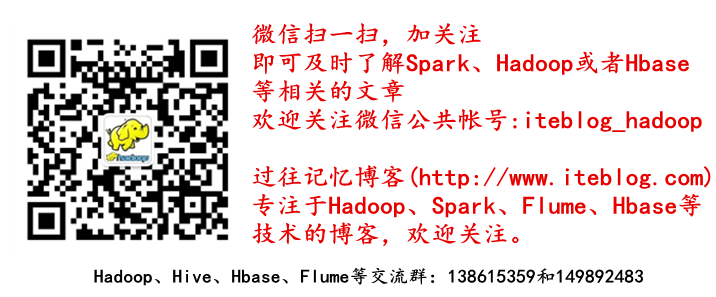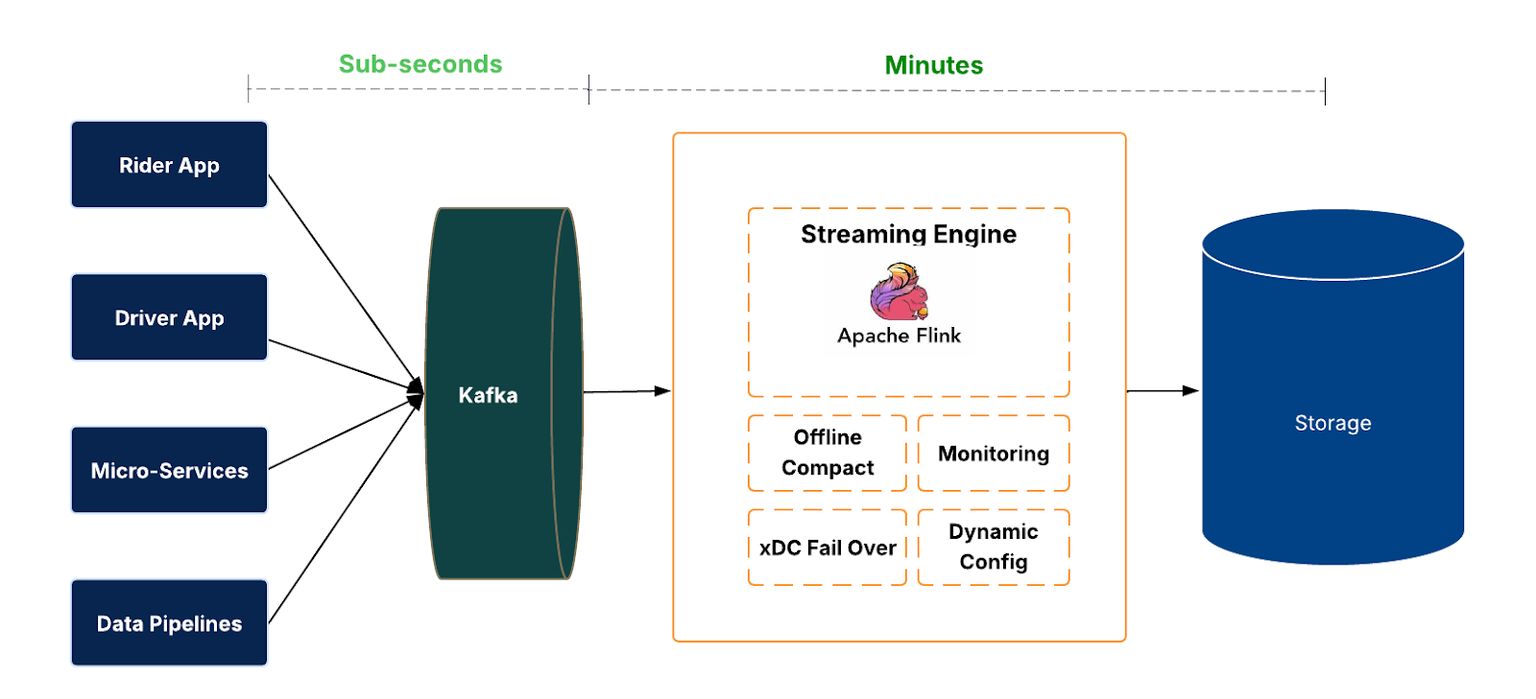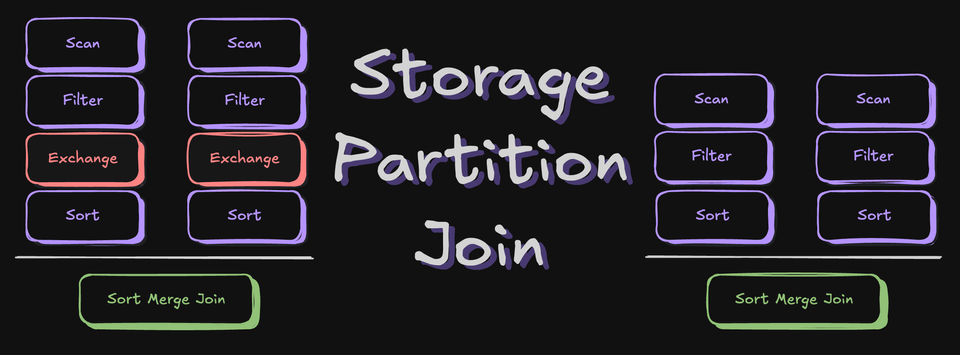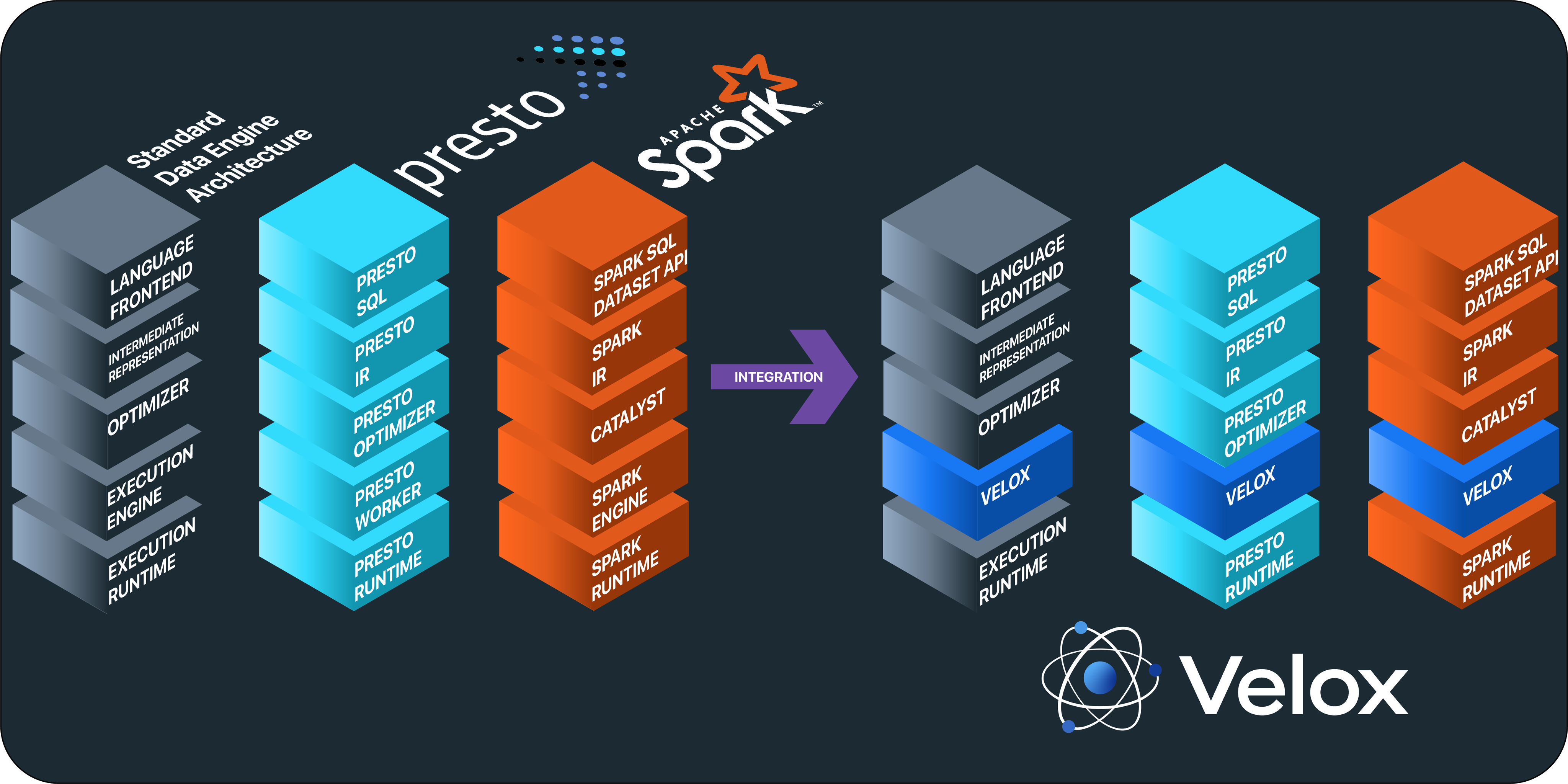《Spark Task序列化代码分析》
《Spark分区器HashPartitioner和RangePartitioner代码详解》
《Spark Checkpoint读操作代码分析》
《Spark Checkpoint写操作代码分析》
上次我对Spark RDD缓存的相关代码《Spark RDD缓存代码分析》进行了简要的介绍,本文将对Spark RDD的checkpint相关的代码进行相关的介绍。先来看看怎么使用checkpont:
scala> val data = sc.parallelize(List("www", "iteblog", "com"))
data: org.apache.spark.rdd.RDD[String] = ParallelCollectionRDD[2] at parallelize at <console>:15
scala> sc.setCheckpointDir("/www/iteblog/com")
scala> data.checkpoint
scala> data.count
先是初始化好相关的RDD,因为checkpoint是将RDD中的数据写到磁盘,所以需要指定一个checkpint目录,也就是sc.setCheckpointDir("/www/iteblog/com"),这步执行完之后会在/www/iteblog/com路径下创建相关的文件夹,比如:/www/iteblog/com/ada54d92-eeb2-4cff-89fb-89a297edd4dc;然后对data RDD进行checkpoint,整个代码运行完,会在/www/iteblog/com/ada54d92-eeb2-4cff-89fb-89a297edd4dc生存相关的文件:
Found 4 items -rw-r--r-- 3 iteblog iteblog 0 2015-11-25 15:05 /www/iteblog/com/ada54d92-eeb2-4cff-89fb-89a297edd4dc/rdd-2/part-00000 -rw-r--r-- 3 iteblog iteblog 5 2015-11-25 15:05 /www/iteblog/com/ada54d92-eeb2-4cff-89fb-89a297edd4dc/rdd-2/part-00001 -rw-r--r-- 3 iteblog iteblog 9 2015-11-25 15:05 /www/iteblog/com/ada54d92-eeb2-4cff-89fb-89a297edd4dc/rdd-2/part-00002 -rw-r--r-- 3 iteblog iteblog 5 2015-11-25 15:05 /www/iteblog/com/ada54d92-eeb2-4cff-89fb-89a297edd4dc/rdd-2/part-00003
现在来对checkpint的相关代码进行简单介绍。首先就是设置checkpint的目录,这个代码如下:
/////////////////////////////////////////////////////////////////////
User: 过往记忆
Date: 2015-11-25
Time: 22:12
bolg:
本文地址:/archives/1535
过往记忆博客,专注于hadoop、hive、spark、shark、flume的技术博客,大量的干货
过往记忆博客微信公共帐号:iteblog_hadoop
/////////////////////////////////////////////////////////////////////
def setCheckpointDir(directory: String) {
// If we are running on a cluster, log a warning if the directory is local.
// Otherwise, the driver may attempt to reconstruct the checkpointed RDD from
// its own local file system, which is incorrect because the checkpoint files
// are actually on the executor machines.
if (!isLocal && Utils.nonLocalPaths(directory).isEmpty) {
logWarning("Checkpoint directory must be non-local " +
"if Spark is running on a cluster: " + directory)
}
checkpointDir = Option(directory).map { dir =>
val path = new Path(dir, UUID.randomUUID().toString)
val fs = path.getFileSystem(hadoopConfiguration)
fs.mkdirs(path)
fs.getFileStatus(path).getPath.toString
}
}
从上面注释可以看出,如果是非local模式,directory要求是HDFS上的目录。事实上,如果你是非local模式,但是指定的checkpint路径是本地路径,程序运行的时候会出现类似以下的异常:
org.apache.spark.SparkException: Checkpoint RDD ReliableCheckpointRDD[1] at count at <console>:18(0) has different number of partitions from original RDD ParallelCollectionRDD[0] at parallelize at <console>:15(4) at org.apache.spark.rdd.ReliableRDDCheckpointData.doCheckpoint(ReliableRDDCheckpointData.scala:73) at org.apache.spark.rdd.RDDCheckpointData.checkpoint(RDDCheckpointData.scala:74) at org.apache.spark.rdd.RDD$$anonfun$doCheckpoint$1.apply$mcV$sp(RDD.scala:1655) at org.apache.spark.rdd.RDD$$anonfun$doCheckpoint$1.apply(RDD.scala:1652) at org.apache.spark.rdd.RDD$$anonfun$doCheckpoint$1.apply(RDD.scala:1652) at org.apache.spark.rdd.RDDOperationScope$.withScope(RDDOperationScope.scala:147) at org.apache.spark.rdd.RDD.doCheckpoint(RDD.scala:1651) at org.apache.spark.SparkContext.runJob(SparkContext.scala:1826) at org.apache.spark.SparkContext.runJob(SparkContext.scala:1837) at org.apache.spark.SparkContext.runJob(SparkContext.scala:1850) at org.apache.spark.SparkContext.runJob(SparkContext.scala:1921) at org.apache.spark.rdd.RDD.count(RDD.scala:1125) at $iwC$$iwC$$iwC$$iwC$$iwC$$iwC.<init>(<console>:18) at $iwC$$iwC$$iwC$$iwC$$iwC.<init>(<console>:23) at $iwC$$iwC$$iwC$$iwC.<init>(<console>:25) at $iwC$$iwC$$iwC.<init>(<console>:27) at $iwC$$iwC.<init>(<console>:29) at $iwC.<init>(<console>:31) at <init>(<console>:33) at .<init>(<console>:37) at .<clinit>(<console>) at .<init>(<console>:7) at .<clinit>(<console>) at $print(<console>) at sun.reflect.NativeMethodAccessorImpl.invoke0(Native Method) at sun.reflect.NativeMethodAccessorImpl.invoke(NativeMethodAccessorImpl.java:57) at sun.reflect.DelegatingMethodAccessorImpl.invoke(DelegatingMethodAccessorImpl.java:43) at java.lang.reflect.Method.invoke(Method.java:606) at org.apache.spark.repl.SparkIMain$ReadEvalPrint.call(SparkIMain.scala:1065) at org.apache.spark.repl.SparkIMain$Request.loadAndRun(SparkIMain.scala:1340) at org.apache.spark.repl.SparkIMain.loadAndRunReq$1(SparkIMain.scala:840) at org.apache.spark.repl.SparkIMain.interpret(SparkIMain.scala:871) at org.apache.spark.repl.SparkIMain.interpret(SparkIMain.scala:819) at org.apache.spark.repl.SparkILoop.reallyInterpret$1(SparkILoop.scala:857) at org.apache.spark.repl.SparkILoop.interpretStartingWith(SparkILoop.scala:902) at org.apache.spark.repl.SparkILoop.command(SparkILoop.scala:814) at org.apache.spark.repl.SparkILoop.processLine$1(SparkILoop.scala:657) at org.apache.spark.repl.SparkILoop.innerLoop$1(SparkILoop.scala:665) at org.apache.spark.repl.SparkILoop.org$apache$spark$repl$SparkILoop$$loop(SparkILoop.scala:670) at org.apache.spark.repl.SparkILoop$$anonfun$org$apache$spark$repl$SparkILoop$$process$1.apply$mcZ$sp(SparkILoop.scala:997) at org.apache.spark.repl.SparkILoop$$anonfun$org$apache$spark$repl$SparkILoop$$process$1.apply(SparkILoop.scala:945) at org.apache.spark.repl.SparkILoop$$anonfun$org$apache$spark$repl$SparkILoop$$process$1.apply(SparkILoop.scala:945) at scala.tools.nsc.util.ScalaClassLoader$.savingContextLoader(ScalaClassLoader.scala:135) at org.apache.spark.repl.SparkILoop.org$apache$spark$repl$SparkILoop$$process(SparkILoop.scala:945) at org.apache.spark.repl.SparkILoop.process(SparkILoop.scala:1059) at org.apache.spark.repl.Main$.main(Main.scala:31) at org.apache.spark.repl.Main.main(Main.scala) at sun.reflect.NativeMethodAccessorImpl.invoke0(Native Method) at sun.reflect.NativeMethodAccessorImpl.invoke(NativeMethodAccessorImpl.java:57) at sun.reflect.DelegatingMethodAccessorImpl.invoke(DelegatingMethodAccessorImpl.java:43) at java.lang.reflect.Method.invoke(Method.java:606) at org.apache.spark.deploy.SparkSubmit$.org$apache$spark$deploy$SparkSubmit$$runMain(SparkSubmit.scala:674) at org.apache.spark.deploy.SparkSubmit$.doRunMain$1(SparkSubmit.scala:180) at org.apache.spark.deploy.SparkSubmit$.submit(SparkSubmit.scala:205) at org.apache.spark.deploy.SparkSubmit$.main(SparkSubmit.scala:120) at org.apache.spark.deploy.SparkSubmit.main(SparkSubmit.scala)
setCheckpointDir的过程主要是在指定的目录下创建一个文件夹,这个文件夹会在后面用到。然后我们对RDD进行checkpoint,主要做的事情如下:
/////////////////////////////////////////////////////////////////////
User: 过往记忆
Date: 2015-11-25
Time: 22:12
bolg:
本文地址:/archives/1535
过往记忆博客,专注于hadoop、hive、spark、shark、flume的技术博客,大量的干货
过往记忆博客微信公共帐号:iteblog_hadoop
/////////////////////////////////////////////////////////////////////
def checkpoint(): Unit = RDDCheckpointData.synchronized {
// NOTE: we use a global lock here due to complexities downstream with ensuring
// children RDD partitions point to the correct parent partitions. In the future
// we should revisit this consideration.
if (context.checkpointDir.isEmpty) {
throw new SparkException("Checkpoint directory has not been set in the SparkContext")
} else if (checkpointData.isEmpty) {
checkpointData = Some(new ReliableRDDCheckpointData(this))
}
}
程序第一步就是判断checkpointDir是否为空,如果为空直接抛出异常,而这个checkpointDir是由上面的setCheckpointDir函数设置的。这里我们应该设置了checkpointDir,所以直接判断checkpointData.isEmpty是否成立,checkpointData是什么东西呢?它的类型如下:
private[spark] var checkpointData: Option[RDDCheckpointData[T]] = None
RDDCheckpointData类是和RDD一一对应的,保存着一切和RDD checkpint相关的所有信息,而且具体的Checkpint操作都是它(子类)进行的。而对RDD调用checkpoint函数主要就是初始化ReliableRDDCheckpointData对象,供以后进行checkpint操作。从这段代码我们知道,对RDD调用checkpoint函数,其实就是初始化了checkpointData,并不立即执行checkpint操作,你可以理解成这里只是对RDD进行checkpint标记操作。
那什么触发真正的checkpoint操作?仔细看上面例子,执行data.count之后才会生成checkpoint文件。是的,只有在Action触发Job的时候才会进行checkpint。Spark在执行完Job之后会判断是否需要checkpint:
def runJob[T, U: ClassTag](
rdd: RDD[T],
func: (TaskContext, Iterator[T]) => U,
partitions: Seq[Int],
resultHandler: (Int, U) => Unit): Unit = {
if (stopped.get()) {
throw new IllegalStateException("SparkContext has been shutdown")
}
val callSite = getCallSite
val cleanedFunc = clean(func)
logInfo("Starting job: " + callSite.shortForm)
if (conf.getBoolean("spark.logLineage", false)) {
logInfo("RDD's recursive dependencies:\n" + rdd.toDebugString)
}
dagScheduler.runJob(rdd, cleanedFunc, partitions, callSite, resultHandler, localProperties.get)
progressBar.foreach(_.finishAll())
rdd.doCheckpoint()
}
注意看最后一句代码rdd.doCheckpoint(),这个就是触发RDD的checkpoint的,而doCheckpoint函数的实现如下:
private[spark] def doCheckpoint(): Unit = {
RDDOperationScope.withScope(sc, "checkpoint", allowNesting = false, ignoreParent = true) {
if (!doCheckpointCalled) {
doCheckpointCalled = true
if (checkpointData.isDefined) {
checkpointData.get.checkpoint()
} else {
dependencies.foreach(_.rdd.doCheckpoint())
}
}
}
}
又看到checkpointData了吧?这个就是在执行checkpint()函数定义的,所以如果你的RDD调用了checkpint()函数,那么checkpointData.isDefined肯定是true的。而如果你的父RDD调用了checkpint()函数,最后也会执行你父RDD的checkpointData.get.checkpoint()代码。我们来看看checkpointData中的checkpoint()是如何实现的,代码如下:
final def checkpoint(): Unit = {
// Guard against multiple threads checkpointing the same RDD by
// atomically flipping the state of this RDDCheckpointData
RDDCheckpointData.synchronized {
if (cpState == Initialized) {
cpState = CheckpointingInProgress
} else {
return
}
}
val newRDD = doCheckpoint()
// Update our state and truncate the RDD lineage
RDDCheckpointData.synchronized {
cpRDD = Some(newRDD)
cpState = Checkpointed
rdd.markCheckpointed()
}
}
为了防止多个线程对同一个RDD进行checkpint操作,首先是把checkpint的状态由Initialized变成CheckpointingInProgress,所以如果另一个线程发现checkpint的状态不是Initialized就直接return了。最后就是doCheckpoint实现了:
/////////////////////////////////////////////////////////////////////
User: 过往记忆
Date: 2015-11-25
Time: 22:12
bolg:
本文地址:/archives/1535
过往记忆博客,专注于hadoop、hive、spark、shark、flume的技术博客,大量的干货
过往记忆博客微信公共帐号:iteblog_hadoop
/////////////////////////////////////////////////////////////////////
protected override def doCheckpoint(): CheckpointRDD[T] = {
// Create the output path for the checkpoint
val path = new Path(cpDir)
val fs = path.getFileSystem(rdd.context.hadoopConfiguration)
if (!fs.mkdirs(path)) {
throw new SparkException(s"Failed to create checkpoint path $cpDir")
}
// Save to file, and reload it as an RDD
val broadcastedConf = rdd.context.broadcast(
new SerializableConfiguration(rdd.context.hadoopConfiguration))
// TODO: This is expensive because it computes the RDD again unnecessarily (SPARK-8582)
rdd.context.runJob(rdd, ReliableCheckpointRDD.writeCheckpointFile[T](cpDir, broadcastedConf) _)
val newRDD = new ReliableCheckpointRDD[T](rdd.context, cpDir)
if (newRDD.partitions.length != rdd.partitions.length) {
throw new SparkException(
s"Checkpoint RDD $newRDD(${newRDD.partitions.length}) has different " +
s"number of partitions from original RDD $rdd(${rdd.partitions.length})")
}
// Optionally clean our checkpoint files if the reference is out of scope
if (rdd.conf.getBoolean("spark.cleaner.referenceTracking.cleanCheckpoints", false)) {
rdd.context.cleaner.foreach { cleaner =>
cleaner.registerRDDCheckpointDataForCleanup(newRDD, rdd.id)
}
}
logInfo(s"Done checkpointing RDD ${rdd.id} to $cpDir, new parent is RDD ${newRDD.id}")
newRDD
}
首先是创建写RDD的目录,然后启动一个Job去写Checkpint文件,主要由ReliableCheckpointRDD.writeCheckpointFile来实现写操作。
def writeCheckpointFile[T: ClassTag](
path: String,
broadcastedConf: Broadcast[SerializableConfiguration],
blockSize: Int = -1)(ctx: TaskContext, iterator: Iterator[T]) {
val env = SparkEnv.get
val outputDir = new Path(path)
val fs = outputDir.getFileSystem(broadcastedConf.value.value)
val finalOutputName = ReliableCheckpointRDD.checkpointFileName(ctx.partitionId())
val finalOutputPath = new Path(outputDir, finalOutputName)
val tempOutputPath =
new Path(outputDir, s".$finalOutputName-attempt-${ctx.attemptNumber()}")
if (fs.exists(tempOutputPath)) {
throw new IOException(s"Checkpoint failed: temporary path $tempOutputPath already exists")
}
val bufferSize = env.conf.getInt("spark.buffer.size", 65536)
val fileOutputStream = if (blockSize < 0) {
fs.create(tempOutputPath, false, bufferSize)
} else {
// This is mainly for testing purpose
fs.create(tempOutputPath, false, bufferSize, fs.getDefaultReplication, blockSize)
}
val serializer = env.serializer.newInstance()
val serializeStream = serializer.serializeStream(fileOutputStream)
Utils.tryWithSafeFinally {
serializeStream.writeAll(iterator)
} {
serializeStream.close()
}
if (!fs.rename(tempOutputPath, finalOutputPath)) {
if (!fs.exists(finalOutputPath)) {
logInfo(s"Deleting tempOutputPath $tempOutputPath")
fs.delete(tempOutputPath, false)
throw new IOException("Checkpoint failed: failed to save output of task: " +
s"${ctx.attemptNumber()} and final output path does not exist: $finalOutputPath")
} else {
// Some other copy of this task must've finished before us and renamed it
logInfo(s"Final output path $finalOutputPath already exists; not overwriting it")
fs.delete(tempOutputPath, false)
}
}
}
写完Checkpint文件之后,会返回newRDD,并最后赋值给cpRDD,并将Checkpint的状态变成Checkpointed。最后将这个RDD的依赖全部清除(markCheckpointed())
private[spark] def markCheckpointed(): Unit = {
clearDependencies()
partitions_ = null
deps = null // Forget the constructor argument for dependencies too
}
整个写操作就完成了。明天将会介绍如何从Checkpint中恢复RDD,请关注本博客,或者iteblog_hadoop公共账号。
本博客文章除特别声明,全部都是原创!原创文章版权归过往记忆大数据(过往记忆)所有,未经许可不得转载。
本文链接: 【Spark Checkpoint写操作代码分析】(https://www.iteblog.com/archives/1535.html)











前辈,您好!非常感谢您的相关文章对一个接触spark人的帮助。
在使用spark streaming过程中,当程序重新编译后,checkpoint文件目录是需要删除的,因为重新编译后的代码不能识别原checkpoint文件中的数据。那么在实际环境中,如果存在程序升级,checkpoint文件被删除,而这个checkpoint保存了需要的数据,请问这种情况应该怎么办呢?
当你的程序升级了,是不能再用之前已经Checkpoint的数据,只能删掉。所以你在实际应用中最好记下程序计算的位置,比如你读取Kafka中的数据,你是可以记下你处理的偏移量的。
感谢您的回复!
我用的是flume + kafka+ spark streaming + Cassandra 架构。使用kafka低阶API接口,updatestatebykey操作来进行流计算,那么这个checkpoint保存了我的 state,checkpoint数据没了,那么我的数据状态丢失,新来的数据就会覆盖原来的数据,从而导致数据丢失。对于这样的使用环境,请问前辈怎么处理?
您继续完成了“明天将会介绍如何从Checkpint中恢复RDD”这个吗?在您的博客里没有找到。
我想在这里问您几个问题:
1. checkpoint如果不想使用时候是否可以在启动stream时候关掉?
2. checkpoint对于输入数据为hdfs上的文件来说,如果stream突然因故障停掉,在恢复以后,文件是否会把之前没有处理过的文件自动重新传输一次呢?还是需要手动?多谢!
从Checkpint中恢复RDD这个还没时间写,有些Streaming操作是不可以关掉checkpoint,比如window相关的操作。